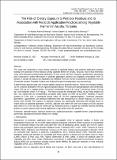| dc.contributor.author | Kiwango, Purificator Andrew | |
| dc.contributor.author | Kassim, Neema | |
| dc.contributor.author | Kimanya, Martin Epafras | |
| dc.date.accessioned | 2019-05-24T06:22:33Z | |
| dc.date.available | 2019-05-24T06:22:33Z | |
| dc.date.issued | 2018-02-19 | |
| dc.identifier.issn | 1927-0895 | |
| dc.identifier.uri | doi:10.5539/ jfr. v7n2p 86 | |
| dc.identifier.uri | http://dspace.nm-aist.ac.tz/handle/123456789/187 | |
| dc.description | Research Article published by Canadian Center of Science and Education; Vol. 7, No. 2; 2018 | en_US |
| dc.description.abstract | This study was
conducted to assess dietary exposure to pesticide residues and pesticide application practices
leading to the presence of these residues among vegetable farmers in Arusha, Tanzani a. Face to face interviews
using semi structured questionnaires (including 24 hour recall and food frequency questionnaire techniques)
were conducted to collect information on pesticide application practices and vegetable consumption from 76
farmers. A sa mple of ready to eat vegetables was collected from each farmer's household to determine the level
of pesticide residues. Pesticide residues were analyzed by gas chromatography mass spectroscopy
A deterministic approach was used to assess dietary exposure t
o pesticide residues. Among the analyzed samples,
31.4% contained detectable levels of organophosphate residues. The detected organophosphates were dimethoate
(mean, 8.56 mg kg 1 ), acephate (mean, 2.9 mg kg 1 ), profenofos (mean, 8.44 mg kg 1 ), dichlorvos mean, 20.8 mg
kg 1 ) and malathion (mean, 5.47 mg kg 1 ). The mean exp osure for dimethoate (0.0021 mg kg 1 body weight (wt)
day 1 was higher than its corresponding acceptable daily intakes of 0.002 mg kg 1 bwd 1 resulting in hazard
quotient of 1.044 with a co nsequent hazard index of 1.19 for organophosphates. Pyrethroid pesticides
(permethrin, cypermethrin, and lambda cyhalothrin) were also detected but at a lower frequency (17.1%) and
hazard index (0.029). The exposure to pesticide residues was significantly associated with limited access to
expert advice on pesticide application ( p =0.031, adjusted odds ratio=6.56) and over dosage ( p =0.038, adjusted
odds ratio=3.751).The risk may be minimized by increasing access to support by extension service providing
guida nce on good practices and ensuring application of app ropriate doses for pesticides. | en_US |
| dc.language.iso | en_US | en_US |
| dc.publisher | Published by Canadian Center of Science and Education | en_US |
| dc.subject | Agricultural extension officers | en_US |
| dc.subject | Pesticide residue | en_US |
| dc.subject | Vegetable farmers | en_US |
| dc.title | The Risk of Dietary Exposure to Pesticide Residues and Its Association with Pesticide Application Practices among Vegetable | en_US |
| dc.type | Article | en_US |

